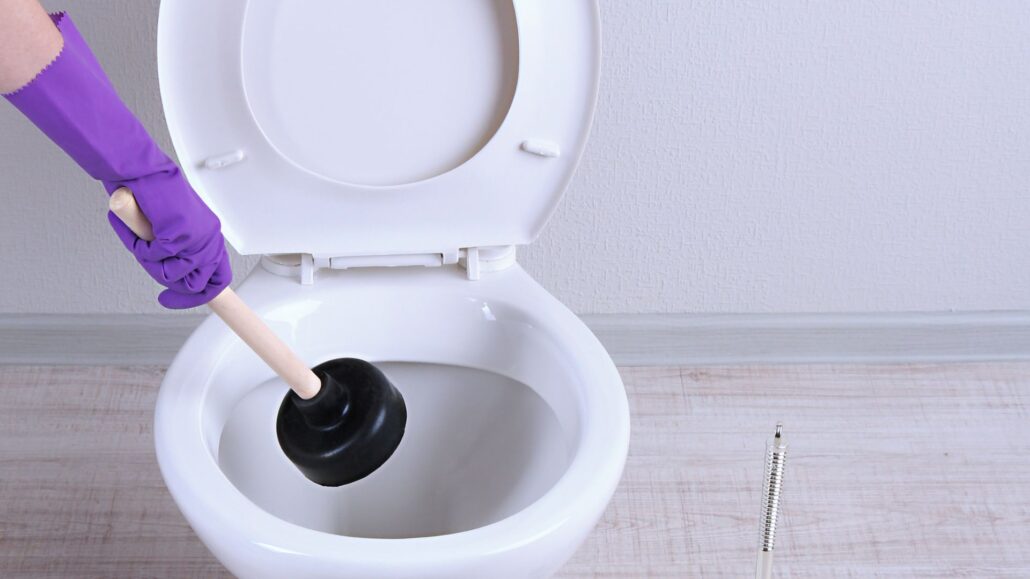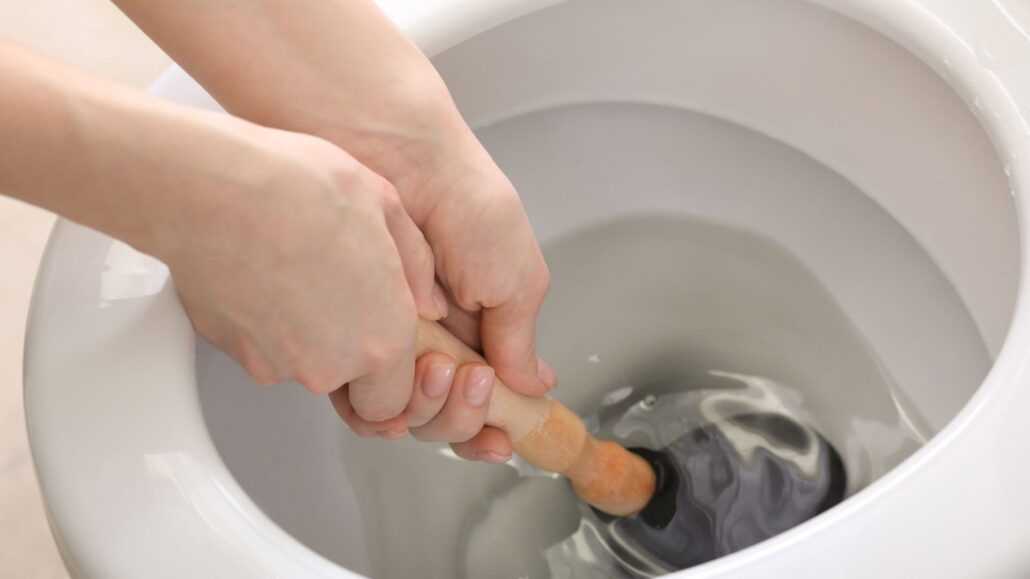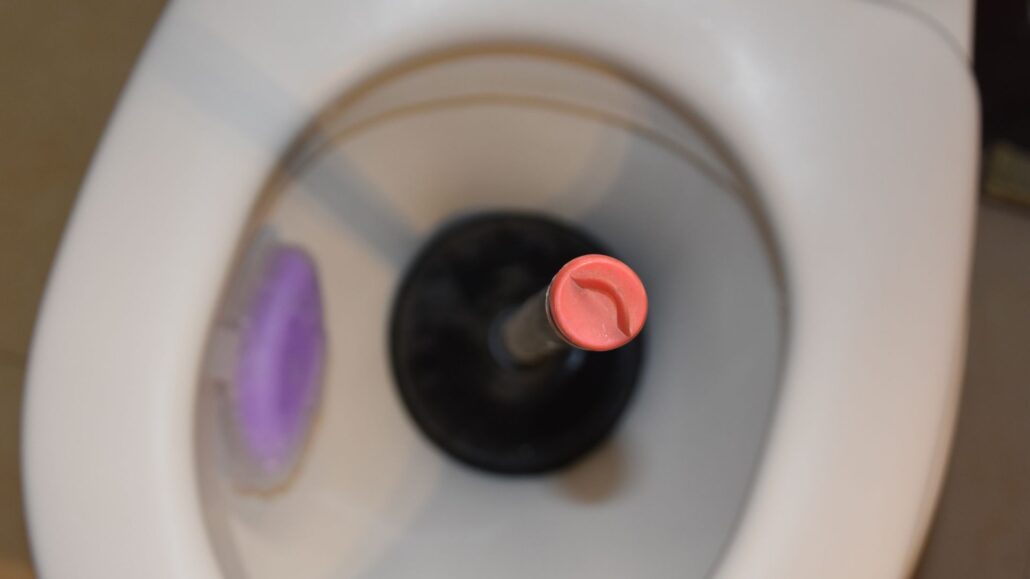Has this ever happened to you – you flush the toilet, and instead of everything disappearing down the drain, the water starts ominously rising? No matter how many times you flush, it just won’t unclog. You desperately plunge a nearby plunger into the bowl, hoping it will work. But the toilet remains blocked, the water continues to creep up, and you’re left frustrated, with an ineffective plunger in hand and no idea what to do next.
It’s a situation no one wants to find themselves in, yet clogged toilets are an inevitable part of homeownership. The key is knowing how to choose the right type of plunger for different toilet blockages. This makes the frustrating unclogging process much easier and more effective.
In this article, we’ll guide you in selecting the most suitable plunger for your type of toilet clog. You’ll learn the best plunger types for common obstructions and proper plunging techniques to clear the blockage quickly. With the right plunger, you can take charge of any clogged toilet dilemma and get your bathroom functioning again in no time.
Plunger Types & Uses
Has this ever happened to you – you flush the toilet, and instead of everything disappearing down the drain, the water starts ominously rising? No matter how many times you flush, it just won’t unclog. You desperately plunge a nearby plunger into the bowl, hoping it will work. But the toilet remains blocked, the water continues to creep up, and you’re left frustrated, with an ineffective plunger in hand and no idea what to do next.
It’s a situation no one wants to find themselves in, yet clogged toilets are an inevitable part of homeownership. The key is knowing how to choose the right type of plunger for different toilet blockages. This makes the frustrating unclogging process much easier and more effective.
In this article, we’ll guide you in selecting the most suitable plunger for your type of toilet clog. You’ll learn the best plunger types for common obstructions and proper plunging techniques to clear the blockage quickly. With the right plunger, you can take charge of any clogged toilet dilemma and get your bathroom functioning again in no time.

Choosing By Toilet Type
When selecting a plunger, it’s important to consider the type of toilet you have – standard, low-flow, or double flush. Each toilet operates differently and requires a specific plunger type to unclog it effectively.
Standard Toilets
Standard toilets are the most common type found in homes. They utilise a standard water volume of 3-5 gallons per flush. A toilet plunger with an extra-long flanged rim is the best option when faced with a clogged standard toilet.
The flanged rim is designed to extend into the opening of the toilet drain and seal securely over the edges. This tight seal focuses the force of plunging directly down into the drain pipe. It also allows the plunger to reach deeper into the pipe to dislodge further down the clogs. The contoured shape funnels the plunging force into the drain for maximum effect.
Low-Flow Toilets
Low-flow toilets operate with 1.6 gallons of water or less per flush. Because of the lower water volume, they are more prone to getting clogged with lightweight debris that gets trapped in the drain pipe.
An accordion plunger is often needed to unclog a low-flow toilet effectively. The collapsible design allows it to compress to fit down into the toilet drain opening. As it’s pulled up, the accordion structure expands and seals tightly against the curves and angles of the pipe. This creates the strong suction necessary to dislodge debris that gets stuck in a low-flow toilet’s narrower drain.
Double Flush Toilets
Double flush toilets feature a split flush system with separate liquid or solid waste buttons. The solid waste setting utilises extra force and water for maximum flushing power.
Because of the intense double flush, clogs in these toilets can become very impacted. To clear them, a heavy-duty plumber’s helper plunger is recommended. The cone-shaped cup provides powerful suction and pressure. The long handle increases leverage for generating the force needed to dislodge stubborn clogs from a double-flush toilet.
Plunger Sizes & Materials

Plunger Sizes
When selecting a plunger, it’s important to pick the right size to fit your toilet’s drain opening properly. A too small plunger will not seal adequately or provide enough suction. On the other hand, an oversized plunger can be difficult to maneuver and plunge efficiently.
The best practice is to closely match the cup size to the diameter of your toilet’s drain. Measure the opening and choose a plunger cup that is just slightly larger to create a tight, secure seal when plunged. This ensures the full force is directed into the clog.
For standard toilet drain openings of around 3-4 inches, a standard medium-sized plunger with a 4-inch cup works well. Larger toilets may require a 4.5-5-inch cup. Take the time to measure and find the right plunger size – it will make a difference in unclogging ability.
Plunger Materials
When it comes to plunger materials, rubber is ideal for its flexibility, grip and ability to form a tight seal. Rigid plastic plungers are cheaper but lack the malleability needed to conform and seal over drain openings.
Rubber plungers also provide better friction and suction against slick porcelain surfaces. Choose high-quality rubber with flex ribs that facilitate suction. Avoid smooth rubber that can slip and lose the seal.
Handles
For handles, contoured wood is preferred for comfort and providing maximum leverage when plunging forcefully. Metal handles may bend or break under robust plunging. Plastic handles are very lightweight but can crack over time. Contoured wood gives the best grip and durability.
The handle length also affects leverage. Longer 18-24 inch handles offer more plunge control and power.
Using Proper Plunging Technique
Using the correct plunging technique is key to effectively unclogging a toilet. Follow these steps for proper technique:
First, position the plunger cup securely over the toilet drain opening. Push down firmly to create an airtight seal around the edges. This seal is crucial to maximise the force of each plunge. Keep pressing down on the handle to maintain the tight seal throughout the process.
With the seal in place, do a series of quick, forceful vertical strokes into the drain. Keep your elbows directly above the handle and utilise your body weight if needed. Avoid twisting motions, which are less effective. The goal is direct, abrupt downward thrusts to dislodge and break up the clog.
Repeat the rapid plunging motion multiple times. It often takes several forceful strokes to dislodge or break up stubborn blockages adequately. After multiple hard plunges, flush the toilet to see if the clog has cleared.
If the obstruction persists, allow the tank to refill after flushing fully. This allows any loosened debris to make its way down the pipes. Once refilled, do another round of quick, robust plunges followed by flushing and checking.
Keep repeating cycles of vigorous plunging, flushing, and checking until the water finally drains normally. Persistence and proper technique are key. The tight seal and direct downward thrusts generate the power needed to clear difficult clogs.
Troubleshooting Tips for Stubborn Clogs

If a toilet clog persists after trying all plunging techniques, don’t give up. There are some troubleshooting tips to attempt before calling a plumber:
- Switch to a plunger with a slightly larger cup diameter. The bigger size provides more force to break up stubborn clogs.
- Fill the toilet bowl to the very top with hot water before plunging. This increases the water pressure behind the plunger seal for more power.
- Ensure the plunger rubber cup still seals completely over the drain opening. Old cracked rubber loses suction. Consider getting a new one.
- Use duct tape or plastic wrap to cover the overflow tube in the tank completely before plunging. This prevents air escape and maximises plunge suction.
- Adjust your body position and technique to utilise your body weight during forceful, direct vertical plunges. Keep the rim sealed tightly.
- Persist with multiple cycles of vigorous plunging followed by flushing. Severe clogs can take many repetitions to fully clear.
If you’ve tried all techniques and tips with no success, the clog may be very deep in the drain pipe, out of the plunger’s reach. At that point, call a professional plumber to utilise a powered drain auger to clear clogs a standard plunger cannot reach.
Frustrated With Clogged Toilets? Call The Brisbane Plumbers!
At The Brisbane Plumbers, we know how frustrating it can be to deal with a clogged toilet. Don’t waste time struggling with the wrong plunger. Our experts help you choose the most effective plunger for your toilet type and teach proven plunging techniques to clear even tough clogs quickly.
We offer fast, affordable plumbing services for all drain issues. Next time you face a blocked bathroom, let The Brisbane Plumbers handle it! Contact us today, and we’ll restore toilet flow and peace of mind.
